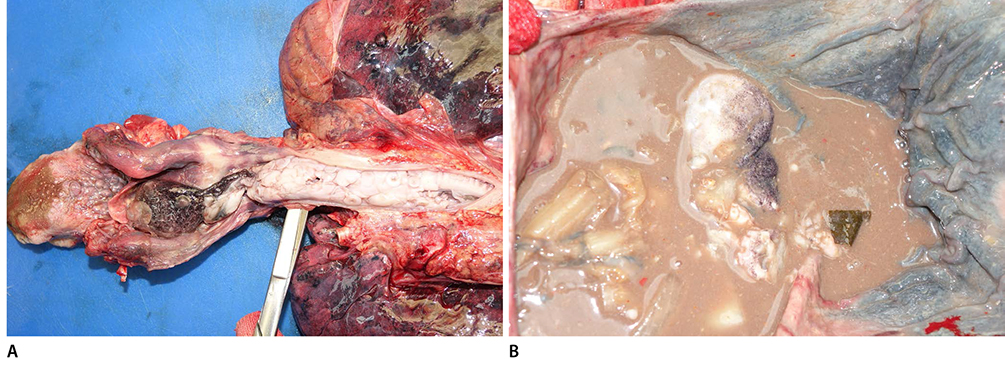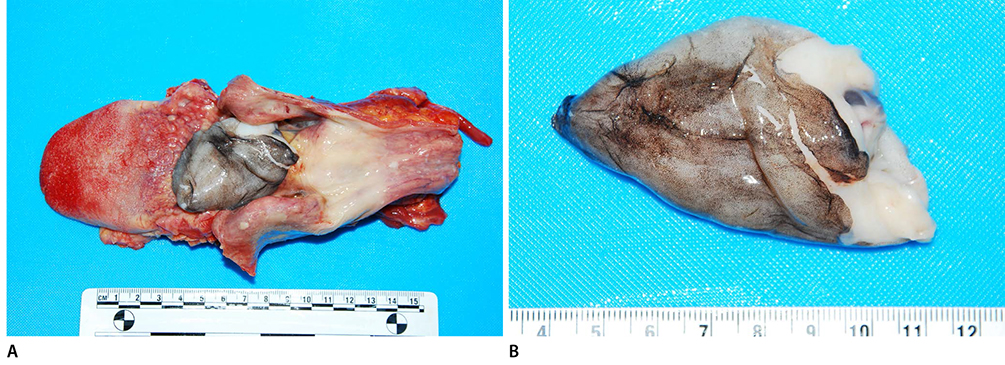Korean J Leg Med.
2018 Nov;42(4):168-171. 10.7580/kjlm.2018.42.4.168.
Accidental Choking Deaths with Octopus minor and Octopus ocellatus
- Affiliations
-
- 1Department of Pathology, Severance Hospital, Yonsei University College of Medicine, Seoul, Korea.
- 2Division of Forensic Investigation, National Forensic Service Seoul Institute, Seoul, Korea. sanchee@korea.kr
- KMID: 2427565
- DOI: http://doi.org/10.7580/kjlm.2018.42.4.168
Abstract
- In Korea, small octopus (Octopus minor) and webfoot octopus (Octopus ocellatus) are food items and fatal laryngeal choking due to ingestion of live octopus is not uncommon. We recently encountered two autopsy cases of accidental choking on small octopus and webfoot octopus. Case 1 involved a 58-year-old fisherman who ingested two live webfoot octopuses in his fishing boat and collapsed. He was immediately taken to the hospital but died. During autopsy, one of the webfoot octopuses was found between his pharynx and esophagus; it was obstructing the epiglottis and upper esophagus. His blood alcohol concentration was 0.140%. Case 2 involved a 55-year-old man who ingested an intact body part of a small octopus and was found dead in his house. He had a history of cerebral infarction and angina pectoris. During autopsy, an intact body part of the small octopus was found to be lodged in the laryngeal inlet.
Keyword
MeSH Terms
Figure
Reference
-
1. Chosun.com. Most of the airway deaths are over 60 years [Internet]. Seoul: Chosun Media;2012. cited 2018 Nov 1. Available from: http://news.chosun.com/site/data/html_dir/2012/09/20/2012092000223.html.2. Kim YS, Lim H. Fatal choking on food/foreign body: 3 autopsy cases. Korean J Legal Med. 2007; 31:95–98.3. Saukko P, Knight B. Knight's forensic pathology. 4th ed. Boca Raton, FL: CRC Press;2014. p. 362–364.4. Madea B. Handbook of forensic medicine. Chichester: John Wiley & Sons;2014. p. 406–409.5. Barbera N, Arcifa V, Valenti V, et al. Fatal asphyxia by complete laryngeal obstruction due to chewing-gum aspiration in an adult woman: case report. Rom J Leg Med. 2012; 20:33–36.
Article6. Ali SR, Mehta AC. Alive in the airways: live endobronchial foreign bodies. Chest. 2017; 151:481–491.7. Busardo FP, Mannocchi G, Pugnetti P, et al. A very unusual accidental mechanical asphyxia of choking with a whole Solea solea. J Forensic Sci. 2017; 62:511–514.8. Deidiker R. Return of the killer fish: accidental choking death on a bluegill (Lepomis macrochirus). Am J Forensic Med Pathol. 2002; 23:197–198.9. Berzlanovich AM, Fazeny-Dorner B, Waldhoer T, et al. Foreign body asphyxia: a preventable cause of death in the elderly. Am J Prev Med. 2005; 28:65–69.
Article10. Nikolic S, Zivkovic V, Dragan B, et al. Laryngeal choking on food and acute ethanol intoxication in adults: an autopsy study. J Forensic Sci. 2011; 56:128–131.
- Full Text Links
- Actions
-
Cited
- CITED
-
- Close
- Share
- Similar articles
-
- Fatal Choking on Food/Foreign Body: 3 autopsy cases
- Examination of The Visual Field Change Results using The Humphrey Visual Field Analyzer and The Octopus Visual Field Analyzer in Early Primary Open Angle Glaucoma
- A Case of Anaphylaxis Due to Raw Octopus variabilis
- Comparison of Ablation Performance between Octopus Multipurpose Electrode and Conventional Octopus Electrode
- Humphrey SITA and Octopus TOP Perimetry on Normal Korean Subjects



